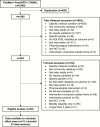A Scoping Review of Nonpharmacological Interventions to Reduce Disability in Older Adults
- PMID: 31002312
- PMCID: PMC7182004
- DOI: 10.1093/geront/gnz026
A Scoping Review of Nonpharmacological Interventions to Reduce Disability in Older Adults
Abstract
Background and objectives: Minimizing disability is critical to reduce the costly health care associated with disability and maintain quality of life into old age. We examined the effect sizes of nonpharmacological intervention studies in reducing disability and explored the active ingredients of interventions.
Research design and methods: A scoping review was conducted via PubMed, PsycINFO, and CINAHL databases. Thirty-one randomized controlled trials were included. Eight active ingredients were identified by three experts (exercise, problem-solving, cognitive behavioral therapy, environmental modification, education, goal setting, comprehensive geriatric assessment, and cognitive training).
Results: The range of Cohen's d was -0.85 to 1.76 across 31 studies (included 33 interventions); 67% studies (n = 22) obtained small-to-negative effect sizes (d = -0.85 to 0.18), accounting for 83% participants across studies. Interventions that incorporated exercise, problem-solving, cognitive behavior therapy, and environmental modification were associated with stronger effect sizes. Interventions that incorporated comprehensive geriatric assessment obtained small effect sizes.
Discussion and implications: Majority of intervention studies found little or no effect in reducing disability for older adults. To optimize the effects of nonpharmacological interventions, we recommend researchers to (i) develop a screening tool for "risk of disability" to inform those who are early on the disability progression, yet not experience any difficulties in activities of daily living and instrumental activities of daily living; (ii) specify the active ingredients embedded in complex interventions to facilitate change in disability; and (iii) select sensitive tools to capture the progression of disability in late life.
Keywords: Active ingredients; Complex interventions; Intervention efficacy.
© The Author(s) 2019. Published by Oxford University Press on behalf of The Gerontological Society of America. All rights reserved. For permissions, please e-mail: journals.permissions@oup.com.
Figures
Similar articles
-
Behavioural modification interventions for medically unexplained symptoms in primary care: systematic reviews and economic evaluation.Health Technol Assess. 2020 Sep;24(46):1-490. doi: 10.3310/hta24460. Health Technol Assess. 2020. PMID: 32975190 Free PMC article.
-
Computerised cognitive training for 12 or more weeks for maintaining cognitive function in cognitively healthy people in late life.Cochrane Database Syst Rev. 2020 Feb 27;2(2):CD012277. doi: 10.1002/14651858.CD012277.pub3. Cochrane Database Syst Rev. 2020. PMID: 32104914 Free PMC article.
-
Effects of caregiver-provided individual cognitive interventions on cognition, social functioning and quality of life in older adults with major neurocognitive disorders: a systematic review.JBI Evid Synth. 2020 Apr;18(4):743-806. doi: 10.11124/JBISRIR-D-19-00125. JBI Evid Synth. 2020. PMID: 32813340
-
Community aging in place, advancing better living for elders: a bio-behavioral-environmental intervention to improve function and health-related quality of life in disabled older adults.J Am Geriatr Soc. 2011 Dec;59(12):2314-20. doi: 10.1111/j.1532-5415.2011.03698.x. Epub 2011 Oct 21. J Am Geriatr Soc. 2011. PMID: 22091738 Free PMC article. Clinical Trial.
-
Depression, cognitive, and functional outcomes of Problem Adaptation Therapy (PATH) in older adults with major depression and mild cognitive deficits.Int Psychogeriatr. 2020 Apr;32(4):485-493. doi: 10.1017/S1041610219001716. Epub 2020 Jan 8. Int Psychogeriatr. 2020. PMID: 31910916 Free PMC article.
Cited by
-
Estimating the effect of health assessments on mortality, physical functioning and health care utilisation for women aged 75 years and older.PLoS One. 2021 Apr 2;16(4):e0249207. doi: 10.1371/journal.pone.0249207. eCollection 2021. PLoS One. 2021. PMID: 33798207 Free PMC article.
-
The reciprocal relationship between depression and disability in low-income homebound older adults following tele-depression treatment.Int J Geriatr Psychiatry. 2021 Jun;36(6):802-810. doi: 10.1002/gps.5480. Epub 2020 Dec 14. Int J Geriatr Psychiatry. 2021. PMID: 33275787 Free PMC article. Clinical Trial.
-
Longitudinal mediation effects of activity meaning on the association between activity performance and quality of life among older adults with disabilities.BMC Geriatr. 2023 Nov 11;23(1):732. doi: 10.1186/s12877-023-04451-7. BMC Geriatr. 2023. PMID: 37951874 Free PMC article.
-
Multi-component cognitive intervention for older adults with mixed cognitive levels: implementation and preliminary effectiveness in real-world settings.BMC Geriatr. 2021 Oct 12;21(1):543. doi: 10.1186/s12877-021-02489-z. BMC Geriatr. 2021. PMID: 34641803 Free PMC article.
-
Effect of social participation on the trajectories of activities of daily living disability among community-dwelling older adults: a 7-year community-based cohort.Aging Clin Exp Res. 2024 May 7;36(1):104. doi: 10.1007/s40520-024-02758-y. Aging Clin Exp Res. 2024. PMID: 38713318 Free PMC article.
References
-
- Abraham C., & Michie S (2008). A taxonomy of behavior change techniques used in interventions. Health Psychology, 27, 379–387. doi:10.1037/0278-6133.27.3.379 - PubMed
-
- Alexopoulos G. S., Raue P. J., Kiosses D. N., Mackin R. S., Kanellopoulos D., McCulloch C., & Areán P. A (2011). Problem-solving therapy and supportive therapy in older adults with major depression and executive dysfunction: effect on disability. Archives of General Psychiatry, 68, 33–41. doi:10.1001/archgenpsychiatry.2010.177 - PMC - PubMed
-
- Arksey H., & O’Malley L (2005). Scoping studies: Towards a methodological framework. International Journal of Social Research Methodology, 8, 19–32. doi:10.1080/1364557032000119616
-
- Ball K., Berch D. B., Helmers K. F., Jobe J. B., Leveck M. D., Marsiske M., … Willis S. L.; Advanced Cognitive Training for Independent and Vital Elderly Study Group (2002). Effects of cognitive training interventions with older adults: a randomized controlled trial. JAMA, 288, 2271–2281. doi:10.1001/jama.288.18.2271 - PMC - PubMed
-
- Binder E. F., Schechtman K. B., Ehsani A. A., Steger-May K., Brown M., Sinacore D. R.,…Holloszy J. O (2002). Effects of exercise training on frailty in community-dwelling older adults: results of a randomized, controlled trial. Journal of the American Geriatrics Society, 50, 1921–1928. doi:10.1046/j.1532-5415.2002.50601.x - PubMed




